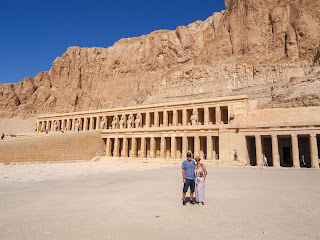The first thing that comes to any ones mind when you mention Luxor is Valley of the Kings, or Thebes as it is known also, where the Kings (Pharoahs) built their tombs. Most of the tombs there were cut into the limestone following a similar pattern: three corridors, an antechamber and a sunken sarcophagus chamber where the mummified body was laid to rest. Of lesser renown is the Valley of the Queens where wives of the Kings were buried. Both of these places are on the West Bank as well as the Mortuary temple of Hatshepsut. We visited all three of these places.
The first was the temple. I was once again speechless as we approached this magnificent multi-tied temple with its grand terraces. The approach to the temple was via long ramps that in ancient times were lined with Sphinx. It was originally many buildings but the main building is all that remains. This photo gives you an idea of what it would have looked like in 1490 BC......
Hatshepsut, who built the temple, was the second female Pharaoh (the Egyptians were way ahead of time!) and ruled for two decades until her step-son, Thutmose III, would come of age to succeed her. It is not known how she died but almost all images of her were destroyed by Thutmose when he came into power. In the surviving images however, she appears as male with the royal headdress and kilt and false beard. Some inscriptions even refer to her as male.
The Valleys of the King and Queens are on the other side of the temple in a very hidden place. To date 64 burial sites have been excavated with Tutenkanam’s being number 62. We travelled by vehicle to the sites and our ticket gave us admission to three of the tombs. Our tour guide suggested Ramsses III, IV and VIIII (3,4,9 and please forgive me if my roman numerals are not correct). No photography is allowed inside the tombs without a special licence but take my word for it they are very special places. You enter the tombs by a wide corridor that are lined with magnificent coloured drawings and stories. The reason we know so much about the history of the ancient Egyptians is because of the details they included in their stories.
After the Valley of the Kings we stopped for a photo shoot at Colossi of Memnon. The remains now are about 23 metres high and weigh a thousand ton. Though damaged by nature and ancient tourists the statues are still impressive.
In the late afternoon we stayed on the East Bank and visited Karnak Temple of Amon that is situated on 247 acres of land. Though badly ruined, the site is impressive. Massive columns still stand as a testament to the building ability of the Egyptians and the site has a central lake with stairs leading to the waters edge that provided a place to bath.
Our last place, and saving the best until last, was the Luxor Temple. We arrived just on dusk and it was the perfect place to watch the sunset. The avenue of the Sphinx links the Luxor Temple to Karnak Temple and is almost 3kms long. Many sphinx still stand and there is ongoing work to repair this magnificent avenue.
This has been a long post but there is just so much to tell! We have only touched the surface of Luxor and you would need at least a week to see and do everything. We left Luxor with a heavy heart (and aching feet!) but god willing we will return.






















No comments:
Post a Comment